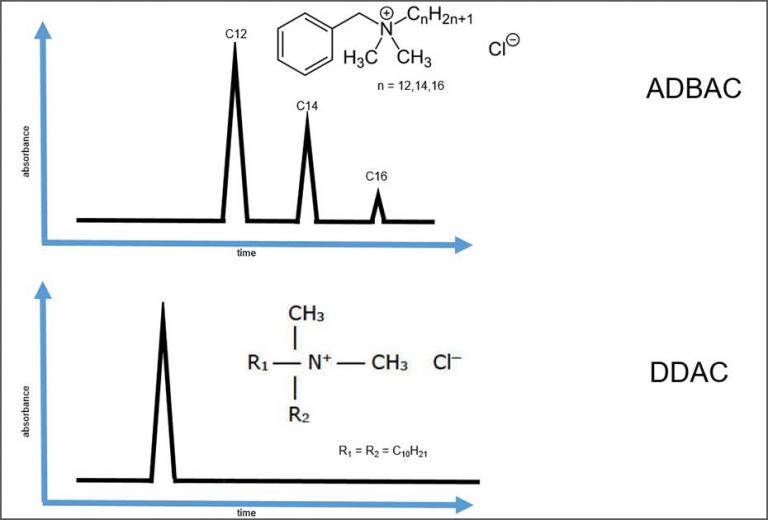How to save time and costs in the analysis of quats
Alkyl dimethyl benzyl ammonium chloride (ADBAC) and didecyldimethyl ammonium chloride (DDAC) both belong to the so-called quaternary ammonium salts (quats). They are often contained in disinfectant mixtures, both individually and as a mixture. It is necessary for manufacturers to carry out a separate method validation for each of the active ingredients contained in the product and furthermore to have the active ingredient content monitored in a stability study. This usually incurs high costs and ties up valuable time. We would like to investigate whether both time and costs can be reduced by using a common analytical approach.
Below are some physico-chemical parameters that need to be monitored during a product stability study:
- Thermal stability: ADBAC and DDAC are thermally stable molecules. Accelerated stability studies performed ad 54°C (according to CIPAC 46.3) and long-term stability studies, performed both at 20°C and at 25°C degrees support this statement.
- Light stability: The two active substances can also be considered light stable, as neither of them absorbs light above 290 nm in the neutral, acidic and basic media.
- Light absorption in the UV range: ADBAC is a mixture of homologues, which absorbs the light in the UV region because of an aromatic ring connected to the alkyl chain. The mixture contains three homologues namely C12, C14 and C16. They differ from one another in the length of the alkyl chain. DDAC presents no chromophore and does not absorb in the UV range. A good compromise that allows the analysis of the two actives at the same time could be the use of High Performance Liquid Chromatography (HPLC) coupled to a number of detectors. UV detector can be used for the analysis of ADBAC, Evaporative Light Scattering Detectors (ELSD) is able to measure the assay of both actives in a formulation and Mass Spectrometer (MS) is able to detect residues of the two actives in different compartments (water, sediment, sludge, soil).
Since ADBAC absorbs in the UV range and DDAC does not, it is therefore difficult to use a common analytical approach to reduce the cost and time of the analyses. In order to determine the level of both active ingredients in the mixture with the same analytical method, it is possible to use a HPLC coupled with both an UV and an ELSD detector. The UV detector is not mandatory since the ELSD is able to measure both actives, but it could be interesting to use it as a control, since ELSD is not a linear detector and UV is.
Conclusion: Using only one method for both active ingredients will reduce method validation time, stability costs and batch release costs and times by almost half.
___
More from our quats series: Do's and don'ts when building a Biocidal Product Family (BPF)
Explore our Biocides solutions
If you have any questions or need more information, please do not hesitate to contact our expert Biocides team.

